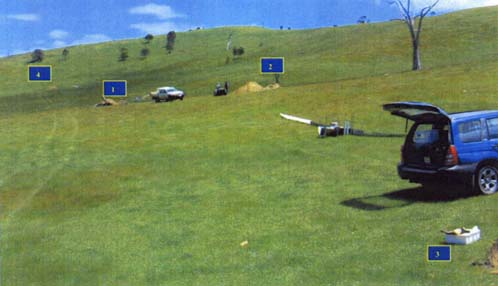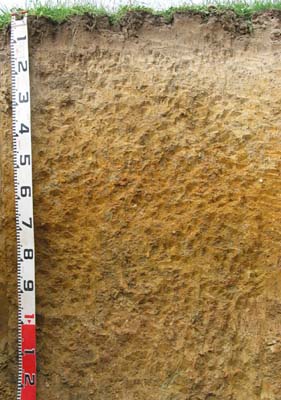CRC10
Location: Ararat
Australian Soil Classification: Mottled-Sodic, Magnesic, Yellow DERMOSOL
General Landscape Description: Mid-slope of hill (SE aspect) - colluvial slope.
Site Description: Grazing paddock – runoff demonstration site.
Geology: Ordovician thinly bedded shale (micaceous).
 CRC10 Landscape |
Soil Profile Morphology
Surface Soil
A1 | 0-5 cm | Brown (10YR4/3); fine sandy loam; weak to moderate coarse-medium blocky structure; weak consistence, moderately moist; pH 4.9; clear change to: |  CRC10 Profile |
A2 | 5-10 cm | Light yellowish brown (10YR6/4); some rusty mottling; sporadically bleached; fine sandy loam; weak to moderate coarse-medium blocky structure; weak consistence, moderately moist; pH 5.2; clear change to: | |
A22 | 10-25 cm | Very pale brown (10YR7/3) with brownish yellow (10YR6/8) mottles; light silty clay loam; weak to moderate medium-fine blocky structure; firm consistence, moderately moist; macropores (with some infill of A horizon material); pH 5.4; clear change to: | |
| Subsoil | |||
B1 | 25-45 cm | Light yellowish brown (10YR6/4) with brownish yellow (10YR6/8) mottles; clay loam (very fine sandy); weak to moderate coarse-medium blocky structure; firm consistence, slightly moist; pH 5.8; gradual change to: | |
B21 | 45-55 cm | Light yellowish brown (10YR6/4) with reddish yellow (7.5YR6/8) mottles; fine sandy light clay; firm consistence, moderately moist; pH 6.3; clear change to: | |
B22 | 55-70 cm | Brownish yellow (10YR6/6) with reddish yellow (7.5YR6/8) mottles; medium clay; moderate-strong coarse-medium blocky structure; firm consistence, moist; pH 6.7; gradual change to: | |
B23 | 70-85 cm | Brownish yellow (10YR6/6) with brownish yellow (10YR6/8) mottles; light clay (silty); moderate very coarse parting to strong coarse-medium blocky further parting to moderate-strong fine polyhedral structure; firm consistence, moist; very few quartz fragments; pH 7.0; gradual change to: | |
B24 | 85-110 cm | Brownish yellow (10YR6/6) with reddish yellow (5YR616) mottles; light clay (silty); moderate-strong coarse, parting to medium, parting to fine polyhedral structure; firm consistence, moderately moist; some manganese staining (2%); pH 7.0; gradual change to: | |
BC | 110+ cm | Light grey (10YR7/1) with reddish yellow (7.5YR6/8) and yellowish red (5YR5/8) mottles; fine sandy clay loam; moderate coarse-medium polyhedral structure; weak consistence, moderately moist; manganese staining (5%); pH 7.8. | |
Key Profile Features
- Gradual increase in clay content (texture) with depth down the upper soil profile.
Key Profile Characteristics
pH | Salinity Rating | |||
Surface (A1 horizon) | Very Strongly Acid | Very Low | Non-Sodic | None |
Subsoil (B21c horizon) | Slightly Acid | Very Low | Non-Sodic | None1 |
Deeper subsoil (at 110+ cm) | Moderately Alkaline | Very Low | Sodic | Strong |
 |
Horizon | Horizon Depth (cm) | pH (water) | pH (CaCl2) | EC dS/m | Exchangeable Aluminium ppm | Exchangeable Acididty meq/100g | Exchangeable Cations | Coarse Sand (0.2-2.0 mm) % | Fine Sand (0.02-0.2 mm) % | Silt (0.002-0.02 mm) % | Clay (<0.002 mm) % | Field Capacity % w/w | Wilting Point % w/w | Bulk Density g/cm3 | |||
Ca | Mg | K | Na | ||||||||||||||
meq/100g | |||||||||||||||||
A1 | 0-5 cm | 4.9 | 4.6 | 0.19 | 20 | 16 | 4.8 | 2 | 0.82 | 0.38 | 9 | 40 | 10 | 25 | 32.5 | 13.8 | 0.97-1.01 (1.00) |
A21 | 5-10 cm | 5.2 | 4.5 | <0.05 | 33 | 6.4 | 1.6 | 1.1 | 0.11 | 0.17 | 1 | 53 | 24 | 16 | 22.4 | 5.7 | 1.02-1.16 (1.09) |
A22 | 10-25 cm | 5.4 | 4.6 | <0.05 | 23 | 2.8 | 1.1 | 0.98 | 0.09 | 0.13 | 1 | 44 | 27 | 12 | 18.5 | 4.6 | 1.0-1.20 (1.11) |
B1 | 25-45 cm | 5.8 | 5 | <0.05 | 19 | 4.1 | 1.1 | 3.1 | 0.12 | 0.25 | 4 | 49 | 24 | 22 | 19 | 8 | |
B21 | 45-55 cm | 6.3 | 5.2 | <0.05 | 12 | 6 | 0.88 | 5.4 | 0.17 | 0.43 | 3 | 39 | 25 | 29 | 26 | 11.5 | |
B22 | 55-70 cm | 6.7 | 5.8 | 0.05 | 5.2 | 0.60 | 7.0 | 0.23 | 0.68 | 2 | 29 | 31 | 38 | 24.3 | 12.5 | 1.46-1.53 (1.48) | |
B23 | 70-85 cm | 7.0 | 6.0 | 0.08 | 4.7 | 0.52 | 9.2 | 0.28 | 1 | 3 | 32 | 28 | 33 | 27.1 | 14 | ||
B24 | 85-110 cm | 7.8 | 6.5 | 0.07 | 0.43 | 11 | 0.19 | 1.5 | 4 | 32 | 34 | 28 | 26.1 | 12.4 | |||
B/C | 110+ cm | 8.2 | 6.6 | 0.05 | 0.15 | 10 | 0.13 | 1.6 | 23.5 | 8.7 | 1.51-1.61 (1.54) | ||||||
Management Considerations:
- The subsoil has very low levels of exchangeable calcium compared to exchangeable magnesium (i.e. magnesic). This indicates that nutrient imbalances may occur (e.g. calcium deficiency).
- The subsoil is dispersive (strongly dispersive at 70 cm depth), which will restrict the movement of roots and water at depth.
Profile described By: Mark Imhof, Austin Brown and Malcolm McCaskill - November 2003.


